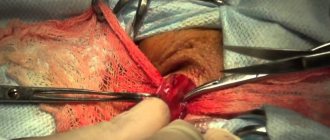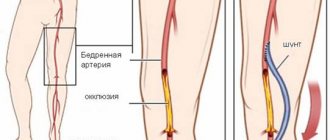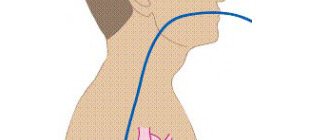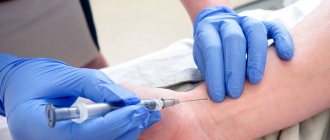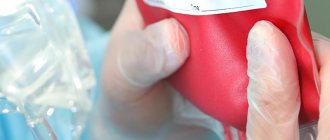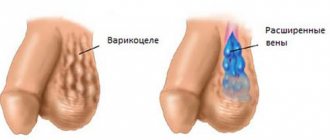Varicocele is a disease that can most often lead to male infertility, but does not affect the man’s health. A person can live his whole life and not know that he had such a disease. Let's look at what this disease is, what diagnostic methods are available, indications for surgical treatment and surgical methods performed in our clinic for the treatment of varicocele.
Varicocele (varicocele; Latin varix, varicis - swelling in the veins, ancient Greek kēlē - tumor) is called varicose veins of the spermatic cord, which is a consequence of the obstructed outflow of venous blood through the system of the internal testicular and other veins draining the testicle.
Varicocele is one of the most common diseases among the male population and is diagnosed in 10-15% of all men. Moreover, if we take all men with infertility, then varicocele is detected in 40% of them. Moreover, if we separately identify a group of men with so-called secondary infertility (that is, those men who previously made women pregnant, but who currently cannot become fathers), it turns out that varicocele occurs in 80% of such men. Since infertility in 30-40% of cases is male, and in 20% mixed, it is necessary to examine both partners.
Indications for surgery
Surgery to remove varicocele is indicated in the following cases:
- painful sensations in the scrotal organs;
- deviations in spermogram parameters;
- changes in the size and density of the testicle, identified as a result of an external examination or ultrasound diagnosis.
The timing of the operation is determined by the indications. In case of dilated vessels, it is better to perform the operation as quickly as possible, without waiting for complications. If there are no visible changes or discomfort, then surgical intervention can be postponed, supportive therapy can be used, and periodic monitoring can be carried out using ultrasound diagnostics.
Stages of the disease
Testicular varicocele occurs in 3 stages:
- First. There are no signs of impairment or discomfort. Pathology can only be determined by touch.
- Second. Varicose veins in the testicular area are noticeable to the naked eye. The testicles themselves, susceptible to varicocele, do not yet experience significant changes.
- Third. In addition to the obvious dilation of blood vessels, one or both testes increase in size. When palpating the testicles, their altered structure is revealed. During this period, the pain is constant, and “clusters” of veins typical for varicocele may form.
To make a diagnosis and determine the stage of the disease in men, a semen analysis is performed. The progression of varicocele is indicated by insufficient sperm motility.
Contraindications
Varicocele surgery is not recommended in the following cases:
- period of puberty in a teenager. At an age when the body is rapidly developing, relapses are possible. In this case, the operation is recommended to be performed when the patient reaches 18 years of age;
- with an asymptomatic course of the disease and no complaints of discomfort from the patient. The operation may not be performed if the patient does not plan to become a father, for example in old age;
- with hemophilia and diabetes mellitus in a state of decompensation.
Strict contraindications are acute conditions in the abdominal cavity, such as appendicitis, peritonitis.
Statistics data
Modern medicine provides the following figures indicating the frequency of the disease:
| Age category of patients | Number of patients diagnosed with varicocele |
| Adult men | 15 people out of 100 |
| Boys 11-14 years old | 8 out of 100 |
| Children 7-10 years old | 1 out of 100 |
More than 80% of cases occur in veins located on the left side. In 15% of patients, a bilateral type of varicocele is observed . The right-sided form of the disease is rare.
The causes of varicocele are not fully understood. Congenital anomalies, a lack of connective tissue in the body, excessive physical activity, and frequent overheating are considered as factors causing testicular pathology.
Preparing for surgery
Varicocele surgery in men is planned, so before performing it it is necessary to undergo a standard examination, which includes:
- general blood and urine tests;
- blood test to identify pathogens of genitourinary infections;
- blood biochemistry;
- coagulogram;
- ECG;
- spermogram.
Be sure to inform your doctor if you are allergic to any medications.
5–7 days before varicocele surgery, it is advisable to stop blood thinning medications. If they are prescribed for health reasons, you must inform your doctor about this.
During the consultation, ask the doctor all the questions you have about how the operation is performed, how long it lasts, and what the prognosis is in your particular case.
How is rehabilitation going?
Recovery after abdominal surgery for a diagnosis of “varicocele ” requires from 7 to 21 days. Minimally invasive methods have a significant advantage in this regard. After such procedures, many men manage to recover in just 3 days.
For successful rehabilitation and prevention of recurrence of varicocele , certain rules should be followed:
- in the first 2-3 days after surgical treatment, avoid any physical activity;
- abstain from sexual intercourse for 1-2 weeks;
- For 7 postoperative days, avoid hot water procedures.
After surgery performed on a patient with varicocele, it is important to strictly follow all the doctor’s recommendations. Do not wet the area where surgical procedures were performed.
You cannot use antibacterial or anti-inflammatory ointments at your own discretion. After surgery, any medications that promote complete cure of varicocele should be prescribed by a specialist.
Varicocele removal methods
Today, several types of surgical treatment of varicocele are practiced.
Classic varicocele surgery using the methods of Ivanissevich and Palomo. Veins are removed in an open manner through incisions measuring 3–5 cm. At the present stage of development of medicine, the methods are considered outdated. The only advantage is the low cost of the operation. There are significantly more disadvantages: a high risk of relapses and complications, a long recovery period.
Laparoscopic varicocele surgery through punctures, which is performed under general anesthesia. The punctures are almost invisible and heal quickly. The method has proven itself well in bilateral pathology. The risk of relapse is minimal.
Endoscopic sclerosis of the affected vessel is performed through a puncture in the femoral vein under the control of a microscope and an X-ray machine. The method is indicated for bilateral pathology, severe pain or asymptomatic disease. The recovery period is very short. The only drawback is the use of x-rays.
Microsurgical operation Marmara. The manipulation is performed under the control of an electron microscope (photo). It allows you to work only with the damaged vessel, without affecting other veins and lymphatic ducts. Today this is the most progressive method of removing varicoceles. It does not require long-term hospitalization, there is practically no recovery period, the incision heals very quickly, and the likelihood of relapse is extremely low.
Advantages of visiting the Professor Kapranov Medical Center
Qualified doctors of our medical center will conduct competent diagnosis and effective treatment of varicocele , which occurs at different stages. Men who contact Professor Kapranov's MC receive the following benefits:
- help from real professionals;
- detailed diagnosis of the body;
- individual approach;
- modern treatment;
- tactful attitude;
- constant medical control.
The clinic uses high-quality medicines from the world's best manufacturers, as well as advanced medical equipment, which contribute to the complete cure of varicocele . For the convenience of clients, comfortable rooms and chambers have been created.
With us you will save time and money. We guarantee high-quality medical care, no queues and affordable cost of services. Waiting for you!
The main activities of the center for endovascular surgery, as well as other popular materials: Treatment of fibroids using the UAE method Where embolization of the uterine arteries is performed in Moscow Embolization of prostate vessels
Laparoscopic clipping for varicocele
Laparoscopic varicocelectomy has many advantages: cosmetic effect, short rehabilitation period and the ability to quickly return to normal life. But at the same time, there is a high risk of affecting the lymphatic pathways. To prevent this from happening, contrast is used.
The use of an endovideosurgical method for treating varicocele allows one to accurately assess the number of branches of the testicular vein and cut them off completely, leaving the artery intact.
Features of the postoperative period.
For the first few hours after surgery, the patient should remain in the clinic under the supervision of qualified medical personnel. The patient can leave the clinic on the same day or the next day after the operation. This is possible if the patient feels satisfactory and if he wishes. For the first time after the operation, it will be necessary to take antibiotics, painkillers, and anti-inflammatory drugs, as recommended by the attending physician. Treatment of the wound with antiseptic solutions and dressing it must be carried out until it heals. Cosmetic intradermal sutures with absorbable synthetic material are placed on the wound, so they do not have to be removed after surgery. You can only take a shower on the eighth day after surgery, and it is important to ensure that the bandage and the area of the postoperative wound remain dry.
For some time after the operation, the patient may be bothered by moderate pain in the area of the postoperative wound, which goes away when taking painkillers - this is normal. Already three days after the operation, the patient can return to work or school, but it is not recommended to engage in sports or heavy physical labor for another month after the operation - this is necessary to prevent the separation of surgical sutures and the recurrence of varicocele.
Features of the operation using the Marmara method
There are several methods for eliminating high pressure and abnormal blood flow in the venous tract of the genital organs. Among the modern methods is the Marmara operation. As a rule, the operation is performed under general anesthesia, because the average duration does not exceed 30 minutes and the patient under general anesthesia is much calmer than under spinal or local anesthesia.
The essence of the operation comes down to the use of techniques:
The surgeon makes surgical access in the area of the outer ring of the inguinal opening, where the spermatic cord extends. The postoperative scar in this area is hardly noticeable, as it passes under the hairline.
Incision with a scalpel up to 4 cm.
Vein ligation. Ligation of damaged veins will be provided. Arteries, lymph nodes, and nerve endings are not damaged during the operation.
Blocking blood flow. After blocking the blood flow in the damaged veins, the surgeon fixes the venous lumen, applies a suture and a sterile bandage.
The procedure involves a minimally invasive operation, after which the patient can go home. The only condition is the patient’s recovery from anesthesia and his state of health.
This is what a postoperative wound looks like immediately after Marmara surgery
The likelihood of developing male infertility
The time has passed when women were considered the main “culprits” of infertile marriages. According to modern data, more than 40% of cases of infertility in men are associated with dilation of the veins of the spermatic cord and testicles, and the prognosis worsens over time. Therefore, operations to eliminate varicocele should be performed at a young age. After successful treatment, the risk of testicular atrophy and infertility is significantly reduced. It is now possible to treat varicocele of any degree using endovascular surgery without incisions and pain, so you should not delay this treatment for a long time.
